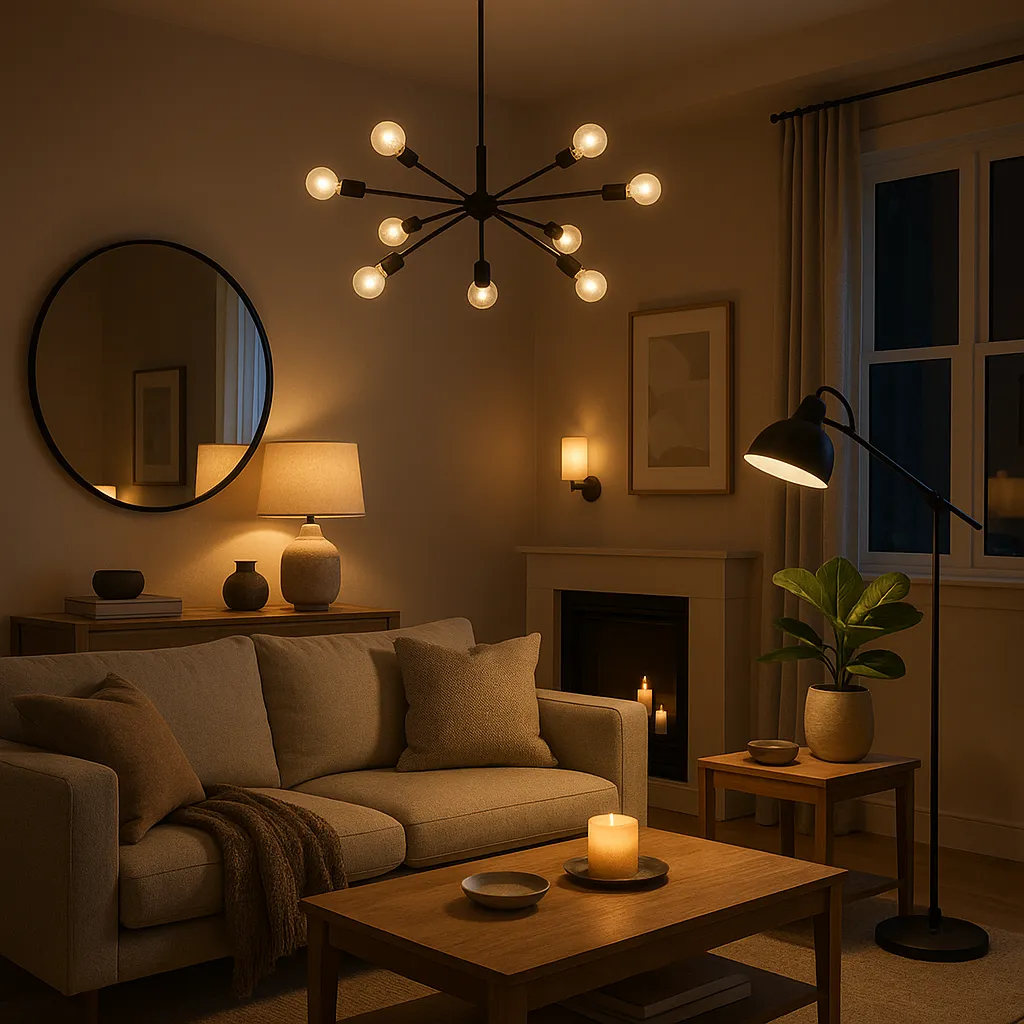Lighting is one of the most powerful yet underrated elements in home decor. It affects how we perceive space, color, texture, and even how we feel in a room. While furniture, paint, and accessories often take center stage, lighting sets the mood, highlights design features, and creates functional living environments. In this guide, you’ll discover how to use lighting to enhance every room in your home—whether you’re going for cozy, modern, dramatic, or functional.
Understand the Three Types of Lighting
Before planning your lighting setup, it’s essential to understand the three main types of lighting used in interior design. A well-lit room usually incorporates all three.
1. Ambient Lighting
Also known as general lighting, ambient lighting provides overall illumination. It ensures a room is well-lit enough for everyday tasks.
- Common examples: ceiling-mounted lights, recessed lighting, chandeliers.
- Best for: living rooms, bedrooms, hallways, and kitchens.
- Tip: Use dimmers to adjust brightness throughout the day.
2. Task Lighting
Task lighting focuses on areas where specific activities take place, like reading, cooking, or working.
- Common examples: desk lamps, under-cabinet kitchen lighting, vanity lights.
- Best for: home offices, kitchens, bathrooms, reading nooks.
- Tip: Position task lighting to avoid shadows while you work or read.
3. Accent Lighting
Accent lighting is used to draw attention to architectural features, artwork, or decor. It adds depth and drama.
- Common examples: wall sconces, LED strip lighting, spotlights.
- Best for: highlighting shelves, artwork, or textured walls.
- Tip: Use warm bulbs to create a cozy ambiance in accent areas.
Using all three types in harmony helps create balanced, layered lighting that can adapt to different needs and times of day.
Choose the Right Light Fixtures
Each light fixture adds its own design value and function. Choosing the right ones is crucial for both style and performance.
Fixture Ideas by Room:
- Living Room: Floor lamps for corners, pendant lights for ambiance, and table lamps on side tables.
- Kitchen: Pendant lights above the island, recessed lighting, and under-cabinet LED strips.
- Bedroom: Wall sconces for reading, pendant lights above nightstands, or soft bedside lamps.
- Bathroom: Backlit mirrors or side sconces for even illumination.
- Home Office: Adjustable desk lamps and ceiling lighting for consistent brightness.
Match fixture styles with your home decor—modern, traditional, rustic, or minimalist.
Pay Attention to Bulb Temperature and Brightness
Not all light bulbs are created equal. The temperature (measured in Kelvins) and brightness (measured in lumens) of a bulb significantly affect the mood of a space.
Temperature Guide:
- 2700K–3000K (Warm White): Cozy and inviting, great for bedrooms and living rooms.
- 3500K–4100K (Cool White): Brighter and more energetic, ideal for kitchens and offices.
- 5000K+ (Daylight): Crisp and bright, best for bathrooms and utility areas.
Brightness Tip:
Use brighter bulbs in task areas and softer lighting in relaxing spaces. Dimmer switches are a great way to control this balance.
Layer Your Lighting
Layering lighting means using multiple light sources at different levels and purposes in the same space. This approach adds flexibility and allows you to change the feel of a room instantly.
How to Layer Lighting:
- Combine ceiling lights (ambient) with table lamps (task) and wall sconces (accent).
- Use multiple light sources in different corners to avoid dark zones.
- Add lighting inside shelves or cabinets for a modern, high-end look.
Layered lighting brings depth and richness to any room, no matter the size.
Highlight Key Features
Lighting can be used to spotlight your favorite design elements or to define zones in open-plan homes.
Highlighting Tips:
- Shine a spotlight on artwork or a gallery wall.
- Use LED strips under floating shelves to emphasize decor.
- Backlight a headboard for a soft glow in the bedroom.
- Frame a mirror with lights to enhance function and style.
Thoughtfully placed lighting turns simple features into focal points.
Use Natural Light to Your Advantage
While artificial lighting is essential, natural light also plays a huge role in home design. It reduces the need for artificial light during the day and improves mood and well-being.
Ways to Maximize Natural Light:
- Use sheer curtains instead of heavy drapes.
- Hang mirrors to reflect light around the room.
- Paint walls in light colors to bounce light further.
- Keep windows clean and unobstructed.
Design your lighting plan to complement natural light during the day and transition into artificial light at night.
Consider Smart Lighting Solutions
Technology has made it easier than ever to control lighting. Smart lighting can save energy and add convenience to your daily life.
Smart Lighting Features:
- Voice or app-controlled lights.
- Scheduled routines for waking up and winding down.
- Color-changing bulbs for different moods.
- Motion-sensor lights for closets, hallways, or entryways.
These systems allow full customization and remote control, perfect for modern lifestyles.
Choose Lighting That Complements Your Decor Style
Lighting isn’t just functional—it’s a major part of your overall aesthetic. The fixtures you choose should enhance your decor and make a statement.
Style Pairing Examples:
- Modern Homes: Sleek fixtures, hidden LEDs, minimalist pendants.
- Farmhouse Style: Wrought iron chandeliers, exposed bulbs, rustic lanterns.
- Scandinavian: Natural wood bases, white lampshades, geometric designs.
- Industrial: Metal fixtures, Edison bulbs, wall-mounted lamps.
When chosen thoughtfully, lighting becomes both an accessory and a tool.
Final Thoughts: Light with Intention
Lighting is more than just a necessity—it’s a vital design element that impacts comfort, mood, and function. By layering lighting, choosing the right temperatures, and highlighting your home’s best features, you can create spaces that feel warm, inviting, and beautifully lit at any time of day.
Remember, the best lighting design considers both beauty and practicality. With the right plan, your lighting will support how you live—and make your home shine in every sense.
